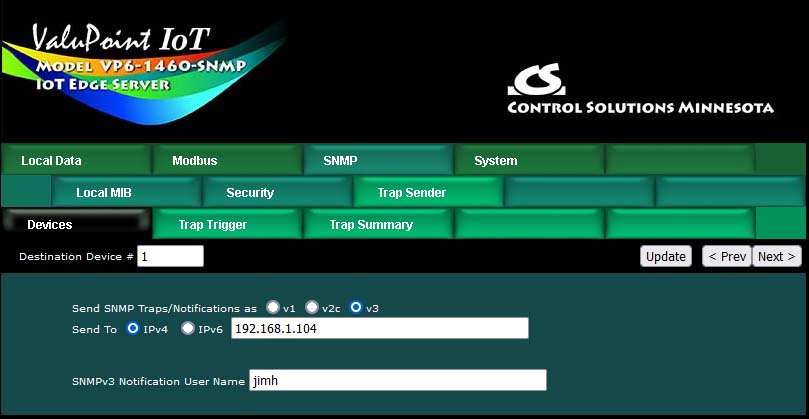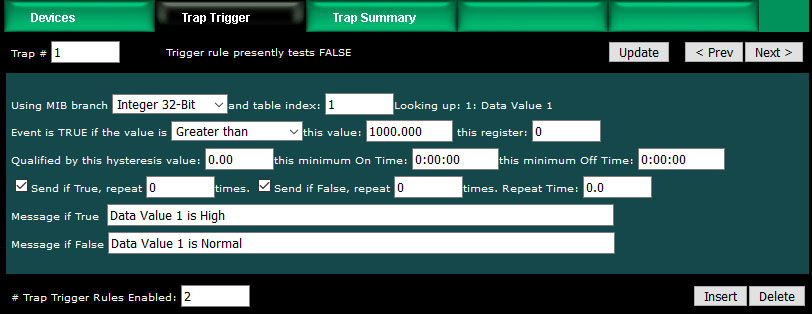
The first step in sending traps is to tell ValuPoint where to send them. This is done on the Devices page of the Trap Sender. Traps or Notifications generated by this device will be sent to port 162 at the IP addresses provided here.

Traps may be sent as v1, v2c or v3. The same application varbinds will be included in either trap type, in addition to header and varbinds required for that trap type. (Note: We use the term "trap" generically here. The v2c/v3 "trap" is properly known as a Notification.)
To remove a destination, simply leave the IP address field blank. To add destinations, or change or remove existing entries, make the necessary changes here, then go to the File Manager page and save your configuration to the Boot configuration XML file. Then restart this device. The trap destinations are loaded one time prior to startup of the SNMP engine. To reload the trap destination table, you must restart the device.
The user name in v1 and v2c traps will be "public". The user name in v3 notifications will be the name entered above. There is only one SNMPv3 Notification user name for all Notification destinations.
Create a Trap Trigger for each trap that should be sent.
A trap must reference a variable in the local MIB. Therefore, before you can create a trap trigger, you must assign the local register of interest to a spot in the local MIB. (See "Configuring ValuPoint as an SNMP Server".) Once the local register has a home in the MIB, select the branch and MIB index in the trap trigger rule. Do not enter local register number here. Enter the MIB table index from your local MIB configuration pages.
The register found in the MIB branch, at the table index given, is displayed for reference as "Looking up...". To change this register, go to that MIB branch and table index, and change the MIB definition, or select a different branch and/or table index.

Once the variable of interest is selected, define the threshold. This will be a test such as "greater than" or "less than", etc. You can provide a fixed value for the threshold, or you may reference a local register that will hold a threshold that may change from time to time. If register is zero, then the fixed value will be used. If a non-zero register number is given, then the fixed value is disregarded. The trap trigger will be "true" when the MIB variable meets the criteria given.
Quaifications are optional, and enabled only when values are nonzero. How hysteresis is applied depends on the comparison. For a test that becomes true if greater than, the test will not return to false until the local register is less than the test value by a margin of at least this hysteresis value. If a test becomes true if less than, it will not return to false until the local register is greater than the test value by a margin of at least this hysteresis value.
Special test types: "Deviates from" will test against the value given, and use Hysteresis as the margin of deviation. This is effectively a "greater than or less than" test for deviation from a setpoint. "Changes by" will become true each time the given variable changes by the value given, and Hysteresis has no effect on this test. If "Changes by" references a value of zero, then this becomes a special test whereby the event is true any time something in the system updates the variable. A "changes by zero" should not be used when the variable is continuously read from a slave device since this will result in continuous traps.
You also have the option of specifying a minimum On and Off time. The "On" time means the rule must test true for this amount of time before the status will actually be set true and the trap will actually be sent. The "Off" time means the rule must test false for this amount of time before its status will actually be returned to false. Times are given in HH:MM:SS format (hours, minutes, seconds).
Check "Send if True" to send traps when the trap trigger rule meets all critera for "true". Check "Send if False" if you would also like to send a trap when the trigger rule meets all criteria for "false".
Enter a repeat count if the trap should be repeated. If repeat count is zero, the trap will be sent one time. If repeat count is 1, the trap will be sent 2 times, and so on. The interval between traps will be the Repeat Time in seconds. Enter -1 for trap repeat count if the trap should simply repeat indefinitely at the Repeat Time interval. A repeat count of -1 for "Send if True" is acceptable. A repeat count of -1 for "Send if False" will be treated as no repeat since indefinite repeating of non-true events is ill-advised.
One of the varbinds in the trap message is an arbitrary ASCII character string, sent as an ASN Octet string. The "True" message will be sent when the trap event is true, and the "False" message will be sent when the trap event is false.
To delete the rule shown, click Delete. To insert a new rule before the rule displayed, click Insert. To add a rule to the end of the list, click Next when at the end of the list, enter new rule, and click Update. The number of rules enabled simply limits the scope of rule review so that you do not have to review a lot of unused rules. If the displayed rules are used up and you need more, increase the enabled number.
The trap summary provides a page where you may see the present status of all of your trap trigger rules. Here we see the "true" status of the above trigger.

A variety of tools are available for browsing an SNMP MIB and receiving SNMP Traps. The tool used in the following examples is the iReasoning MIB Browser. Refer to the Tools section under Support at csimn.com for more information about SNMP tools.
The iReasoning MIB Browser allows you to browse the MIB, do table walks, etc., but of primary interest here, also allows you to test traps. When you open the iReasoning browser, under Tools, select Trap Receiver. The screen illustrated below shows the trap viewer after receiving the above trap from our ValuPoint.
